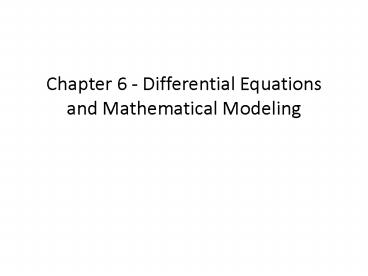Chapter 6 - Differential Equations and Mathematical Modeling - PowerPoint PPT Presentation
1 / 44
Title:
Chapter 6 - Differential Equations and Mathematical Modeling
Description:
Chapter 6 - Differential Equations and Mathematical Modeling Example: About the line y = 1 Find the volume of the solid generated by revolving the region bounded by ... – PowerPoint PPT presentation
Number of Views:335
Avg rating:3.0/5.0
Title: Chapter 6 - Differential Equations and Mathematical Modeling
1
Chapter 6 - Differential Equations and
Mathematical Modeling
2
6.1 Slope Fields and Eulers Method
An equation involving a derivative is called a
differential equation. The order of a
differential equation is the order of the highest
derivative involved in the equation.
3
First-order Differential Equation
If the general solution to a first-order
differential equation is continuous, the only
additional information needed to find a unique
solution is the value of the function at a single
point, called an initial condition. A
differential equation with an initial condition
is called an initial-value problem. It has a
unique solution, called the particular solution
to the differential equation.
4
Ex Find the particular solution to the equation
whose graph
passes through the point (0,3).
5
Slope Field
- The differential equation gives the slope at any
- point (x, y). This information can be used to
- draw a small piece of the linearization at that
- point, which approximates the solution curve
- that passes through that point. Repeating that
- process at many points yields an approximation
- called a slope field.
- Graph the family functions that solve the
differential equation - .
6
Example Constructing a Slope Field
7
We will now do some extra activities with slope
fields after 6.4 and how they relate to the AP
exam. Homework p.327 (1-39)odd
8
6.2 Antiderivation by Substitution
Indefinite Integral
9
(No Transcript)
10
(No Transcript)
11
(No Transcript)
12
Homework p. 337 (1-69)odd
13
7.2 Areas in the Plane
Area Between Curves
14
Area Between Curves
15
How to find the area between two curves Step 1
Graph the curves and determine which is on
top Step 2 Find the limits of
integration Step 3 Write a formula for
Step 4 Integrate
from a to b.
16
Ex Find the area of the region R in the first
quadrant that is bounded above by
and below by the x-axis and the line y x - 2.
17
Make a choice to find the area of the region
enclosed by the graphs y x3 and x y2 2.
Example Using Geometry
18
Homework p. 395 (1 49) odd
19
6.4 Exponential Growth and Decay
Separable Differential Equation
20
A special example
21
The Law of Exponential Change
22
Continuously Compounded Interest
23
Homework p. 357 (1-14)
24
6.5 Logistic Growth
25
Homework p.369 (1-22)
26
7.3 Volumes
Volume of a Solid
How to Find Volumes by the Method of Slicing
27
(No Transcript)
28
29
(No Transcript)
30
(No Transcript)
31
Example Volume of a Wedge A curved wedge is cut
from a cylinder of radius 3 by two planes. One
plane is perpendicular to the axis of the
cylinder. The second plane crosses the first
plane at 450 angle at the center of the cylinder.
Find the volume of the wedge.
32
Solids of Revolution Circular Cross
Sections The most common application of the
method of slicing is to solids of revolution.
Solids of revolution are solids whose shapes can
be generated by revolving plane regions about the
axes. The Disk Method
33
Example About the x-axis The region between the
curve , and the x-axis is revolved about the
x-axis to generate a solid. Find its volume.
34
Example About the line y 1 Find the volume of
the solid generated by revolving the region
bounded by and the lines y 1, x 4 about the
line y 1.
How to find volume using the Disk Method Step 1
Draw the region and identify the radius
function Step 2 Square the radius function and
multiply by pi Step 3 Integrate to find the
volume
35
Example Revolution about the y-axis Find the
volume of the solid generated by revolving the
region between the y-axis and the curve ,
about the y-axis.
36
Example Revolution about a vertical axis Find
the volume of the solid generated by revolving
the region between the parabola and the line x
3 about the line x 3
37
Washer Cross sections If the region we revolve
to generate a solid does not border on or cross
the axis of revolution, the solid has a hold in
it. The cross sections perpendicular to the axis
of revolution are washers instead of
disks. Outer radius R(x) Inner
radius r(x) The washers area is
38
Example Rotation about the x-axis The region
bounded by the curve y x2 1 and the line y
-x 3 is revolved about the x-axis to generate a
solid. Find the volume of the solid.
39
- How to find volume using washer cross sections
- Draw the region and sketch a line segment across
it perpendicular to the axis of revolution. - Find the limits of integration
- Find the outer and inner radii
- Integrate
- Example Rotation about the y-axis
- The region bounded by the parabola y x2 and the
line y 2x in the first quadrant is revolved
about the y-axis to generate a solid. Find the
volume of the solid.
40
- Homework
- 406 (1 42)
- No shell problems
41
8.2 LHôpitals Rule
LHôpitals Rule First Form
42
LHôpitals Rule Stronger Form
43
(No Transcript)
44
Homework p. 450 (1-16)































